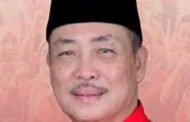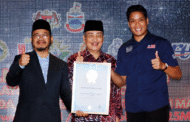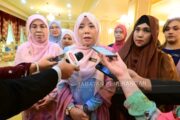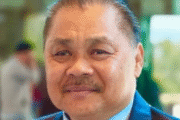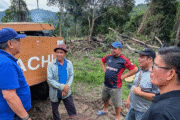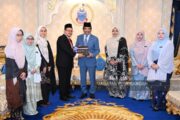Liew (middle), flanked by KePKAS Permanent Secretary Datuk Josie Lai (right) and Dr Wong, displaying a sun bear soft toy and a promotional bag at the BSBCC’s souvenir gift shop.
SANDAKAN: The Tourism, Culture and Environment Ministry (KePKAS) has nurtured the growth and development of the Bornean Sun Bear Conservation Centre (BSBCC) since its inception in 2008.
Its Minister Datuk Seri Christina Liew said BSBCC, the only one of its kind in the world for protection of this endangered species, is a partnership project with the Sabah Wildlife Department (JHL), an agency under the Ministry, and Sabah Forestry Department.
Sun bear is a Class 1 Protected Species under the state’s Wildlife Conservation Enactment 1997.
“Last year, we (KePKAS) allocated RM228,420 for the construction of Phase 1 of the Entrance Foyer, which has since been completed. This year saw an additional allocation of RM250,000 for construction of Phase 2 of the Entrance Foyer. Work is expected to start this year,” Liew told reporters after a recent visit to the Centre here.
The Minister noted that this 17-year-old tourist attraction, which is home to 42 rescued sun bears, draws local and international visitors like a magnet.
“I was informed by its Founder and CEO Dr (Hon) Wong Siew Te that the Centre received 79,362 visitors in 2024, with an average of 6613 visitors per month. That year, there were international visitors from 115 countries with the United Kingdom, Australia and Italy being the top three international nationalities that visited the Centre.
“The peak season is from July to October generating the most number of visitors. In fact, we have more Malaysian visitors during the school holidays,” she said.
Educationists, researchers, school children and teachers, wildlife conservationists, animal lovers and the like make up the composition of visitors and tourists, the majority being nature lovers and nature-based tourists. Many may not be aware that the BSBCC is also the main implementing agency for the 10-Year State Sun Bear Action Plan, Liew said.
The main attraction to visitors at BSBCC is watching the sun bears’ natural behaviour in their natural habitat, the rainforest. “Sometimes visitors can see the bears climbing and sleeping high on the trees. Random feedings enable the visitors to see them eating as well,” said Dr Wong.
According to him, all the sun bears at the BSBCC have been rescued from illegal pet keeping after their mothers were brutally killed by poachers. Over the past 17 years, the JHL has rescued 70 sun bear orphans and sent them to the conservation centre, he disclosed.
Liew commended Dr Wong for his unwavering commitment, patience and perseverance in keeping the BSBCC afloat, despite the multiple challenges that came his way.
In a guided tour, he drew the Minister’s attention to sun bears kept in Pen B, C and D, where visitors can view and learn about them. “We regard them as ambassadors for their species to raise awareness among the general public, apart from being subjects of our research projects,” said the wildlife conservationist.
Sharing his multitasking role as the founder and owner of BSBCC, Dr Wong said : “Since founding the Centre 17 years ago, I have been running the place at all levels, from designing the facility, taking care of the bears, and conducting education and research programs to development of the Centre and fund-raising efforts. Everything that you can think of, even gardening and cleaning the toilets.
“We try our best to take good care of the bears and rehabilitate them. Thirteen rescued sun bears were successfully rehabilitated and released back into the wild. In addition, the latest two rescued sun bear cubs have been sent to Tabin Wildlife Reserve to undergo the ‘soft-release’ program.”
Acknowledging the Ministry’s contribution, Dr Wong said KePKAS has helped BSBCC a lot for the past 17 years. “The Ministry even helped us to raise funds for the Centre to get off the ground in 2008, and gave us a grant for our operational cost in 2013. I hope the Ministry will continue to support our work in the future.”
He said the Sabah Tourism Board (STB), an agency under KePKAS, has assisted him in many ways to promote the Centre to the local tourism market and internationally, too. “On our part, our promotional efforts are through social media platforms (FB, Tiktok, X, YouTube) and websites.”
In retrospect, Dr Wong said in the infant years (from 2008 to 2013), BSBCC survived on public donations and grants from various funders across the world, adding “Since opening to the public on January 16, 2014, we have been depending heavily on ticketing fees and souvenir purchase revenue to run the centre. ”
Admittedly, his greatest challenge in operating the Centre is the need to seek sufficient funds, not only to maintain the facility but also to expand it wherever necessary. “Yes, finding competent staff to help me manage the Centre is also a big challenge.”
On his future plans, the farsighted Founder and CEO envisions a third observation platform, an interpretation centre and new office building, and a captive breeding enclosure. “For BSBCC, these construction plans need financing. I have an undying passion and boundless energy to work for another 30 years. By that time, I am sure I have a lot of successors who can take over my life mission,” said Dr Wong.
He added that he still needs to raise RM1,000,000 to build the Field Office and staff house for the Tabin Sun Bear Project













